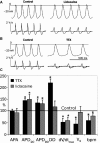Effects of 4-aminopyridine on action potentials generation in mouse sinoauricular node strips
- PMID: 26156968
- PMCID: PMC4552527
- DOI: 10.14814/phy2.12447
Effects of 4-aminopyridine on action potentials generation in mouse sinoauricular node strips
Abstract
The physiological role of Ito has yet to be clarified. The goal of this study is to investigate the possible contribution of the transient outward current (Ito) on the generation of transmembrane action potentials (APs) and the sensitivity of mouse sinoauricular node (SAN) cells to a 4-aminopyridine (4AP) as Ito blocker. The electrophysiological identification of cells was performed in the sinoauricular node artery area (nstrips = 38) of the subendocardial surface using microelectrode technique. In this study, for the first time, it was observed that dependence duration of action potential at the level of 20% repolarization (APD20) level under a 4AP concentration in the pacemaker SAN and auricular cells corresponds to a curve predicted by Hill's equation. APD20 raised by 70% and spike duration of AP increased by 15-25%, when 4AP concentration was increased from 0.1 to 5.0 mmol/L. Auricular cells were found to be more sensitive to 4AP than true pacemaker cells. This was accompanied by a decrease in the upstroke velocity as compared to the control. Our data and previous findings in the literature lead us to hypothesize that the 4AP-sensitive current participates in the repolarization formation of pacemaker and auricular type cells. Thus, study concerning the inhibitory effects of lidocaine and TTX on APD20 can explain the phenomenon of the decrease in upstroke velocity, which, for the first time, was observed after exposure to 4AP. Duration of AP at the level of 20% repolarization (APD20) under a 4-AP concentration 0.5 mmol/L in the true pacemaker cells lengthen by 60-70% with a control.
Keywords: 4‐aminopyridine; TTX; mouse; sinoauricular node; transmembrane action potential.
© 2015 The Authors. Physiological Reports published by Wiley Periodicals, Inc. on behalf of the American Physiological Society and The Physiological Society.
Figures




Similar articles
-
[The involvement of lidocaine and tetrodotoxin-sensitive current in the generation of action potentials with low DV/DT max in the cells of the mouse sinoauricular region].Fiziol Zh (1994). 2013;59(5):31-40. Fiziol Zh (1994). 2013. PMID: 24400563 Russian.
-
[Comparison of the electrophysiological features between the rhythmic cells of the aortic vestibule and the sinoatrial node in the rabbit].Sheng Li Xue Bao. 2003 Aug 25;55(4):405-10. Sheng Li Xue Bao. 2003. PMID: 12937819 Chinese.
-
pH-dependent actions of 4-aminopyridine on atrial repolarization: effects on the transient outward current.Can J Physiol Pharmacol. 1996 Mar;74(3):305-12. Can J Physiol Pharmacol. 1996. PMID: 8773411
-
[Transient outward potassium current and repolarization of cardiac cells].Bull Acad Natl Med. 1998;182(2):325-33; discussion 333-5. Bull Acad Natl Med. 1998. PMID: 9648347 Review. French.
-
Characterization of the effects of ryanodine, TTX, E-4031 and 4-AP on the sinoatrial and atrioventricular nodes.Prog Biophys Mol Biol. 2008 Jan-Apr;96(1-3):452-64. doi: 10.1016/j.pbiomolbio.2007.07.003. Epub 2007 Aug 1. Prog Biophys Mol Biol. 2008. PMID: 17850852 Review.
Cited by
-
Multi-Scale Assessments of Cardiac Electrophysiology Reveal Regional Heterogeneity in Health and Disease.J Cardiovasc Dev Dis. 2018 Mar 8;5(1):16. doi: 10.3390/jcdd5010016. J Cardiovasc Dev Dis. 2018. PMID: 29517992 Free PMC article. Review.
-
Open-source low-cost cardiac optical mapping system.PLoS One. 2022 Mar 31;17(3):e0259174. doi: 10.1371/journal.pone.0259174. eCollection 2022. PLoS One. 2022. PMID: 35358183 Free PMC article.
-
Intracellular Na+ Modulates Pacemaking Activity in Murine Sinoatrial Node Myocytes: An In Silico Analysis.Int J Mol Sci. 2021 May 26;22(11):5645. doi: 10.3390/ijms22115645. Int J Mol Sci. 2021. PMID: 34073281 Free PMC article.
-
Sinoatrial Node Structure, Mechanics, Electrophysiology and the Chronotropic Response to Stretch in Rabbit and Mouse.Front Physiol. 2020 Jul 22;11:809. doi: 10.3389/fphys.2020.00809. eCollection 2020. Front Physiol. 2020. PMID: 32774307 Free PMC article.
-
Microelectrode Array Recording of Sinoatrial Node Firing Rate to Identify Intrinsic Cardiac Pacemaking Defects in Mice.J Vis Exp. 2021 Jul 5;(173):10.3791/62735. doi: 10.3791/62735. J Vis Exp. 2021. PMID: 34279515 Free PMC article.
References
-
- Aréchiga-Figueroa IA, Rodríguez-Martínez M, Albarado A, Torres-Jácome J. Sánchez-Chapula JA. Multiple effects of 4-aminopyridine on feline and rabbit sinoatrial node myocytes and multicellular preparations. Pflugers Arch. 2010;459:C345–C355. - PubMed
-
- Boyett MR, Honjo H, Yamamoto M, Nikmaram MR, Niwa R. Kodama I. Regional differences in effects of 4-aminopyridine within the sinoatrial node. Am. J. Physiol. 1998;275:C1158–C1168. - PubMed
-
- Boyett MR, Honjo H, Lei M. Kodama I. Transient outward K+ current, ito, in the sinoatrial node. Cardiovasc. Res. 2001;52:C519–C520. - PubMed
-
- Golovko VA. Ion and temperature effect on generation of cardiac rhythm of vertebrates. Leningrad: Nauka; 1989. p. 152.
LinkOut - more resources
Full Text Sources
Other Literature Sources
Miscellaneous

